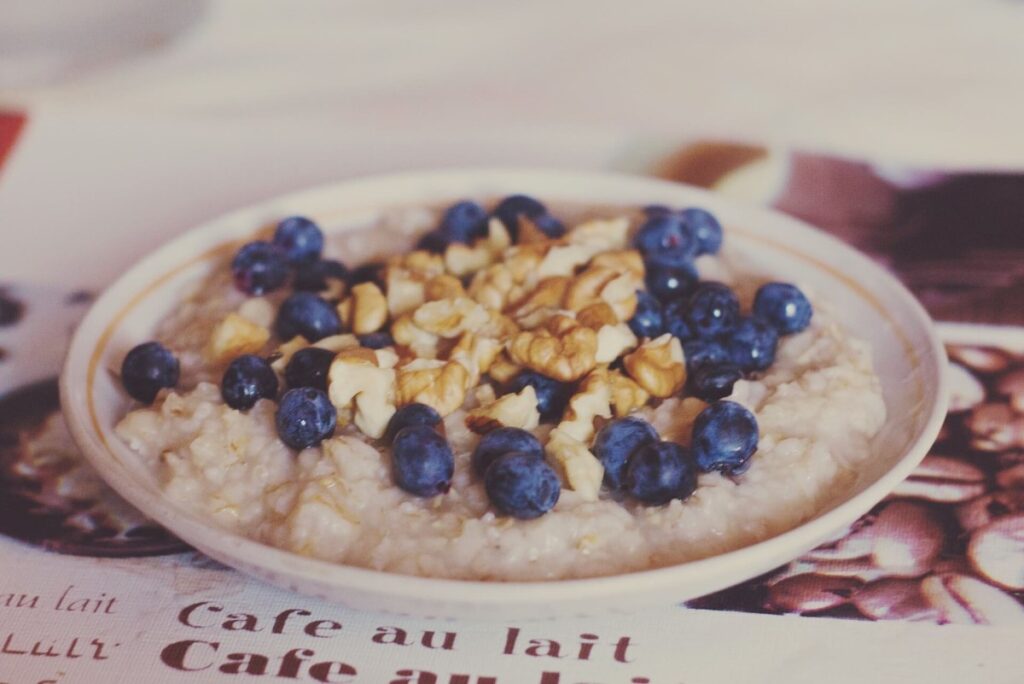Carbohydrates are usually the main ingredient of the human diet, covering 40-60% of energy intake daily. Bread, pasta, rice – we eat them very frequently, but often, not being aware of the content, we choose simple and refined sugars. The complexity of carbs matters and has a really big impact on our health. Unless you are in 1% of the population with celiac disease or base your nutrition on a ketogenic diet, wholegrain foods should be found on the list of what you eat, and I will prove to you why.
What is a whole grain?
For the grain to be considered a whole grain, it needs to have 3 original components: bran, germ, and endosperm. On the other hand, to classify it as refined, it needs to go through a mechanical process of grinding or sifting, which makes it lose the bran and germ. Therefore, the whole grain has a lot more nutritional value than refined grains, especially it is a healthy source of fiber and vitamins.
|
Examples of wholegrain products |
Examples of refined grain |
|
|
Note: Always read the label! If the bread is dark, it doesn’t mean that it’s healthy. A supermarket bread may contain chemical raising agents, flavor enhancers, preservatives, or caramel as a colorant to make us think what’s dark is healthy. For this reason, it’s good to buy the bread with the available composition, or even better – to make a homemade wholegrain bread.
Popcorn – a lot of commercial types of microwave popcorn (salted or buttered) contain trans fats. Therefore, the healthiest option is to buy natural corn kernels, without any additions.
Okay, you already know which are the wholegrain products, now let’s move on to 5 reasons why is it worthy to eat them…
1. Disease prevention
Eating wholegrain products is considered a preventive factor against chronic diseases. Two large prospective studies were done in US upon this topic. The analysis proved a significant connection between whole grain consumption and mortality risk. The authors concluded that each 28g/day serving of whole grains was associated with 5% lower total mortality and 9% lower cardiovascular disease mortality1.
Additionally, a systematic review of meta-analysis proved the correlation between whole grain intake and cancer risk (especially pancreatic, gastric, and esophageal). Similarly, the conclusion was that each 30g/day portion lowers the risk of cancer by ~7%2.
2. Fiber
Fiber is a very important component of the diet. What’s interesting, unlike proteins, fats, and carbs, fiber isn’t digested, but after the passage through the digestive system, it’s expelled. WHO recommends eating between 20-40g of fiber/day, depending on the sex and age. Benefits of high fiber intake(https://www.mayoclinic.org/healthy-lifestyle/nutrition-and-healthy-eating/in-depth/fiber/art-20043983):
- stimulates bowel peristalsis
- lowers LDL (‘bad’) cholesterol level
- helps to control blood sugar level
- reduces blood pressure
Fiber content comparison (in 100g of dry product):

Brown rice 12g vs White rice 0,4g
Whole wheat bread 7g vs White bread 1g
Wholegrain pasta 12g vs White pasta 3,2g
Oatmeal 10g vs Corn flakes 3,3g
Popcorn 13g Chips (crisps) 4g
3. Satiation
Long-lasting satiation after eating whole grain foods is also associated with fiber. However, I wanted to point it out, because of obesity disease. That’s right, many people are unaware that excess body fat is considered a disease. And it is also the best reason to develop many other, more dangerous conditions, such as diabetes, high blood pressure, or even some cancers.
From the fat loss point of view, we should especially avoid simple carbs, because soon after their consumption, we get hungry again. Longer satiation is beneficial for keeping a reasonable calory intake and therefore body weight. If you struggle with a constant hunger and/or fat loss, consider that a higher fiber intake might be the key factor to handle these problems. Especially if products like pasta and bread are frequently found on your plate.
4. Stable source of energy
Another disadvantage of refined grains is how fast they provide and simultaneously drain the energy from the body. The difference lays in the structure – simple carbohydrates have a shorter chain of sugar molecules (1 or 2) than complex ones (3 and more). Our bodies transform that sugar into glucose, which is our primary source of energy. Thereby, the more complex the structure, the longer it takes to digest, which results in slower and more steady energy release (https://www.medicalnewstoday.com/articles/325171).
5. Vitamins and minerals
For the body to function properly, it needs to have a sufficient amount of particular vitamins and minerals. Wholegrain products are a great source of B vitamins, iron, magnesium, phosphorous, selenium, or zinc. What’s worth noting, is the fact that vitamins from B group are not stored in the organism (except of B12), therefore, we need to remember to deliver their sufficient amounts to our bodies. Below more precisely about the vitamins and minerals, as well as their content in wholegrain products.
|
Vitamin/Mineral |
Functions |
Nutrient Reference Value for an adult (% in 100g of dry product) |
|
B vitamins |
Cell division, proper energy conversion, helps to sustain good skin condition |
· Quinoa (B1 30%, B6 37%, folic acid 46%)
· Wholegrain wheat flour (B1 73%, folic acid 36%) · Brown rice (B1 45%, B3 41%) · Wild rice (B3 42%, B6 30%) · Oatmeal (B1 38%) |
|
Iron |
Crucial in hemoglobin synthesis, proper functioning of the nervous and immune system |
· Quinoa (57%)
· Oatmeal (53%) · Spelt flakes (45%) · Wholegrain wheat flour (47%) |
|
Magnesium |
Supports proper muscle and nerve functioning and helps to keep a low blood pressure |
· Quinoa (49%)
· Wholegrain wheat flour (47%) · Wild rice (44%) · Bulgur (41%) · Spelt flakes (36%) · Oatmeal (35%) · Brown rice (29%) |
|
Phosphorous |
Helps to maintain healthy teeth and bones, supports muscle contraction and nervous system functioning |
· Wholegrain wheat flour (76%)
· Spelt flakes (71%) · Wild rice (62%) · Oatmeal (59%) · Quinoa (59%) · Brown rice (44%) · Bulgur (43%) |
|
Selenium |
Helps to create antioxidant enzymes that prevent cell damage |
· Oatmeal (53%)
· Brown rice (31%) |
|
Zinc |
Supports immune system, cell division and growth, wound healing, breakdown of carbs and it’s also needed to maintain smell and taste senses |
· Wholegrain wheat flour (60%)
· Wild rice (54%) · Oatmeal (33%) · Spelt flakes (31%) |
6. Price and preparation
A lot of unaware people think that to eat healthy you need to spend a fortune. But that’s not the case, especially with wholegrain foods. All the products I mentioned (except of wild rice) are very affordable and moreover easy to prepare. A pack of 400g of groats or brown rice costs merely 2-5 PLN and delivers 4-8 portions. They might be used in a variety of different dishes and substitute overused in Polish cuisine potatoes as a side dish. The boiling time is usually around 10-35 min., but you if you don’t like to wait, you can prepare more portions and keep it in the fridge for the next few days. And be creative, groats don’t mean only salty dishes, for example, millet is widely used in sweet types of breakfast. And when it comes to them…

Rolled oats are also ridiculously cheap and simultaneously full of healthy nutrients. They can be used in form of typical oatmeal, or, after blending, also in pancakes and other pastries. They require only 6min of boiling to be ready. Or, if you need to grab it to work, leave it in the fridge overnight soaked in milk/water. Oatmeal perfectly fits with all kinds of fruits, nuts, and protein powder flavors, if you seek a high protein meal. Therefore, due to the possible combinations, taste, and nutritional value, I personally eat rolled oats several times a week for breakfast.
Summary
To create a healthy and sustainable diet, the crucial is to build strong fundaments. So be a conscious consumer and choose products that nourish your body instead of damaging it. You need to respect what nature gives – wholegrain products are unprocessed, and that’s why they provide tons of nutrients. If you’ve been choosing refined grains until today, I hope better wellbeing and mitigated disease risk are strong arguments to swap them for wholegrain foods.
References
- Wu H, et al. Association between dietary whole grain intake and risk of mortality: two large prospective studies in US men and womenAssociation between dietary whole grain intake and risk of mortality: two large prospective studies in US men and women; 2015
- Gaesser GA., Whole Grains, Refined Grains, and Cancer Risk: A Systematic Review of Meta-Analyses of Observational Studies; 2020

Amazing article! Thank you for the precious information, I found them very relevant and helpful. I also love how they are organized and summarized in tables. Keep up with your fantastic work!
Thank you! I really appreciate such constructive comments 🙌